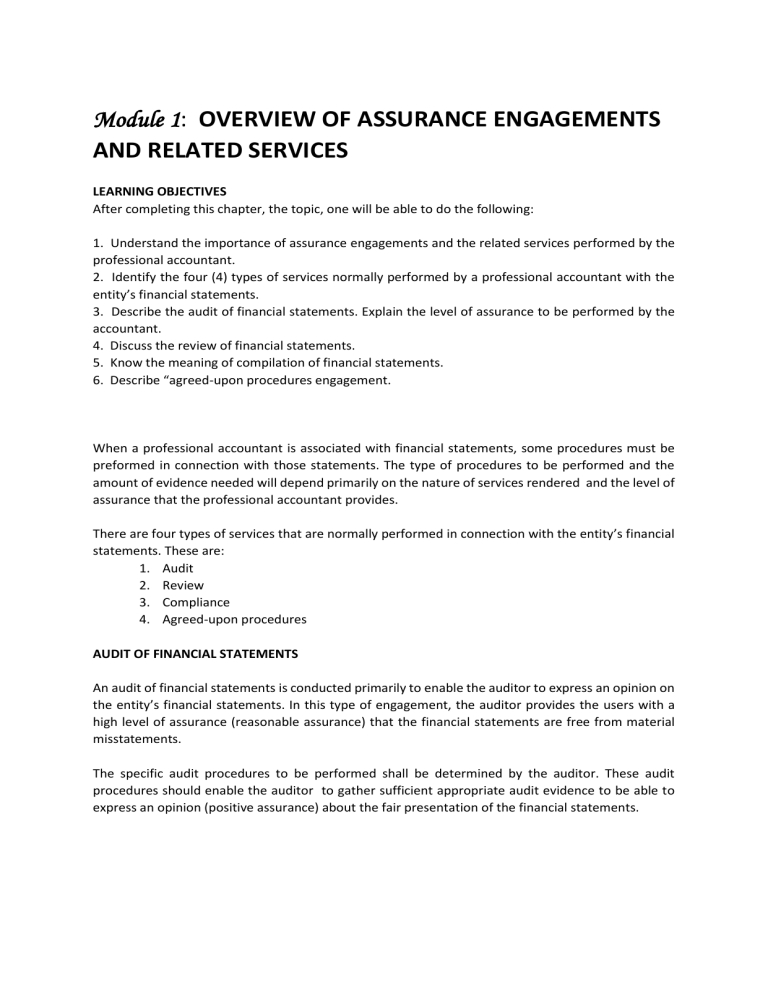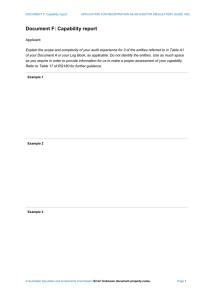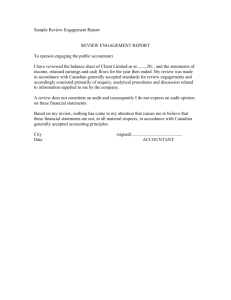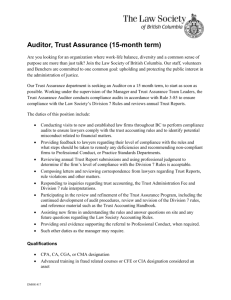Module-1-OVERVIEW-OF-ASSURANCE-ENGAGEMENTS-AND-RELATED-SERVICES
advertisement

Module 1: OVERVIEW OF ASSURANCE ENGAGEMENTS AND RELATED SERVICES LEARNING OBJECTIVES After completing this chapter, the topic, one will be able to do the following: 1. Understand the importance of assurance engagements and the related services performed by the professional accountant. 2. Identify the four (4) types of services normally performed by a professional accountant with the entity’s financial statements. 3. Describe the audit of financial statements. Explain the level of assurance to be performed by the accountant. 4. Discuss the review of financial statements. 5. Know the meaning of compilation of financial statements. 6. Describe “agreed-upon procedures engagement. When a professional accountant is associated with financial statements, some procedures must be preformed in connection with those statements. The type of procedures to be performed and the amount of evidence needed will depend primarily on the nature of services rendered and the level of assurance that the professional accountant provides. There are four types of services that are normally performed in connection with the entity’s financial statements. These are: 1. Audit 2. Review 3. Compliance 4. Agreed-upon procedures AUDIT OF FINANCIAL STATEMENTS An audit of financial statements is conducted primarily to enable the auditor to express an opinion on the entity’s financial statements. In this type of engagement, the auditor provides the users with a high level of assurance (reasonable assurance) that the financial statements are free from material misstatements. The specific audit procedures to be performed shall be determined by the auditor. These audit procedures should enable the auditor to gather sufficient appropriate audit evidence to be able to express an opinion (positive assurance) about the fair presentation of the financial statements. REVIEW OF FINANCIAL STATEMENTS The cost of the audit may not justify the benefits that other entities may derive from it. Consequently, small entities usually request the professional services of the auditor to provide them with certain level of assurance about the reliability of the financial statements. The objective of a review of financial statements is to enable an auditor to state whether, on the basis of procedures which do not provide all the evidence that would be required in an audit, anything has come to the auditor’s attention that causes the auditor to believe that the financial statements are not prepared, in all material respects, in accordance with an identified financial reporting framework. Level of Assurance Because of the limited procedures performed when reviewing financial statements, the auditor does not provide the same level of assurance as provided on audit engagements. A review engagement can only provide moderate level of assurance that the information subject to review is free of material misstatements. This moderate assurance is expressed in the review report in the form of negative assurance such as “Nothing came to my attention………”. Or “I am not aware of any material modifications….” Procedures to be performed A review of financial statements consists principally of inquiry and analytical procedures. While a review involves the application of audit skills and techniques in gathering evidence, it does not ordinarily involved an assessment of accounting and internal control. Systems, test of records and of responses to inquiries by obtaining cost of through inspection, observation, comfirmation and computation. If the auditor has reason to believe that the information subject to review may materially misstated, the auditor, should carryout additional or more extensive procedures as be necessary to be able to express negative assurance or to confirm that a modified report is required. REPORTING RESPONSIBILITY The review report should contain a clear written expression of negative assurance. The auditor should review and asses the conclusion shown drawn from the evidence obtained as the basis for the expression of negative assurance COMPILATION OF FINANCIAL STATEMENTS Not all entities can employ full time accountant to prepare financial statements for them. As a result, most of these entities turn to professional accountants to assist them in the preparation and presentation of their financial statements. this engagement is known as compilation engagement. The objective of a compilation engagement is for the accountant to use accounting expertise, as opposed to auditing expertise, to collect, classify, and summarize financial information. This ordinarily entails reducing detailed data to a manageable and understandable form without a requirement to test the assertions underlying that information. A compilation engagement would ordinarily include the preparation of financial statements (which may or may not be a complete set of financial statements) but may also include the collection, classification, and summarization, of other financial information. Level of Assurance The procedures employed in a compilation engagement are not designed and do not enable the accountant to express any assurance on the financial information. However, users of the compiled financial information derive some benefit as a result of the accountant’s involvement because the service has been performed with professional competence and due care. Procedures to be performed The accountant should read the compiled information and consider whether it appears to be appropriate in form and free from material misstatements. The accountant is not ordinarily required to: a. Make any inquiries of management to assess the reliability and completeness of the information provided. b. Assess internal controls c. Verify any matters; or d. Verify any explanations. If the accountant becomes aware that information supplied by management is incorrect, incomplete, or otherwise unsatisfactory, the accountant should consider performing the above procedures and request management to provide additional information. If management refuses to provide additional information, the accountant should withdraw from engagement, informing the entity of the reason for the withdrawal. If the accountant becomes aware of misstatement, the accountant should try to agree appropriate amendments with the entity. If such amendments are not made and the financial information is considered to be misleading, the accountant should withdraw from the engagement. Reporting Responsibility The accountant’s compilation report should identify the financial statements compiled and should clearly indicate that no assurance is provided on the financial statements. the financial information compiled by the accountant should contain a reference such as “Unaudited”, Compiled without audit or Review”, or “Refer to Compilation Report” on each page of the financial information or on the front of the complete set of financial statements. AGREED-UPON PROCEDURES ENGAGEMENT An auditor may be engaged to apply agreed-upon procedures on specific account or element of a financial statement. This type of engagement may be accepted provided: a. The client takes full responsibility for the adequacy of the procedures to be performed; and b. The distribution of the report is limited to those parties o has agreed about the procedures to be performed. The objectives of an agreed -upon procedures engagement is for the auditor to carry out procedures of an audit nature to which the auditor and the entity and any appropriate third parties have agreed and to report on factual findings. Level of Assurance As the auditor simply provides a report of the factual findings of the agreed-upon procedures , no assurance is expressed. Instead, users of the report assess for themselves the procedures and findings reported by the auditor and draw their own conclusions from the auditor’s work. Restriction on the distribution of report The report is restricted to those parties that have agreed in the procedures to be performed since others, unaware of the reasons for the procedures, may misinterpret the result. Terms of the engagement The auditor should ensure with representatives of the entity, and ordinarily, other specified parties, who will received copies, copies of the report of factual findings, that there is a clear understanding of the agreed procedures and the conditions of the engagement. Procedures and evidence The auditor should carry out the procedures agreed upon and used the evidence obtained as the basis for the report of factual findings. These are also audit procedures but usually applied only to specific accounts or elements of a financial statement. These procedures may include: a. Inquiry and analysis b. Recomputation, comparison, and other clerical accuracy checks c. Observation d. Inspection e. Obtaining confirmation Reporting Responsibility The report on an agreed procedures engagement needs to describe the purpose and the agreed upon procedures of the engagement in sufficient detail to enable the reader to understand the nature and the extent of the work performed. QUESTIONS TO PONDER 1. Discuss the following services performed by the professional accountant: a. Audit b. Review c. Compilation d. Agreed-upon procedures 2. Identify the level of assurance provided by each service in #1. Explain. Reference: Roque, Gerardo S. (2018-2019). CPA EXAMINATION REVIEWER: AUDITING PROBLEMS. Manila: GIC ENTERPRISES & CO., INC. Roque, Gerardo S. (2018-2019). CPA EXAMINATION REVIEWER: AUDITING THEORY. Manila: GIC ENTERPRISES & CO., INC. Salosagcol, Jekell, Tiu, Michael, and Hermosilla, Roel. (2018). Auditing Theory: A Guide In Understanding the Philippine Standards on Auditing. Manila: GIC ENTERPRISES & CO., INC. Valix, Conrado T, Peralta, Jose F., and Valix, Christian Aris M. (2019). CPA EXAMINATION: PRACTICAL ACCOUNTING VOLUME ONE. Manila: GIC ENTERPRISES & CO., INC. Prepared by: LEONARDO M. PALO, CPA, DBA FACULTY



